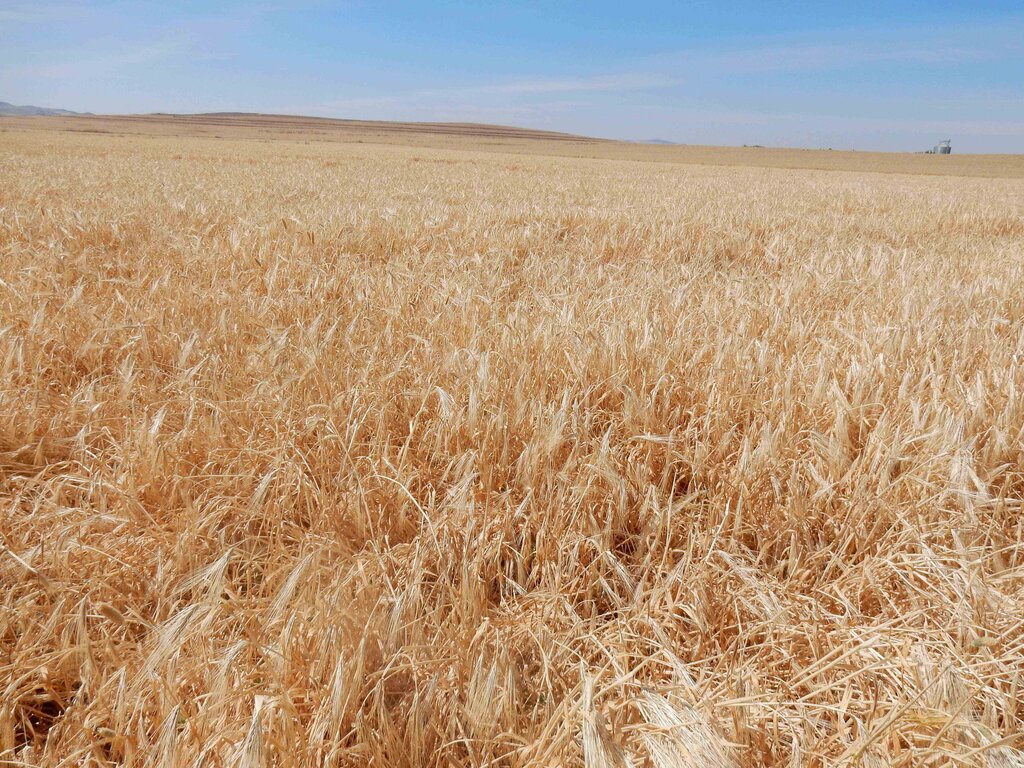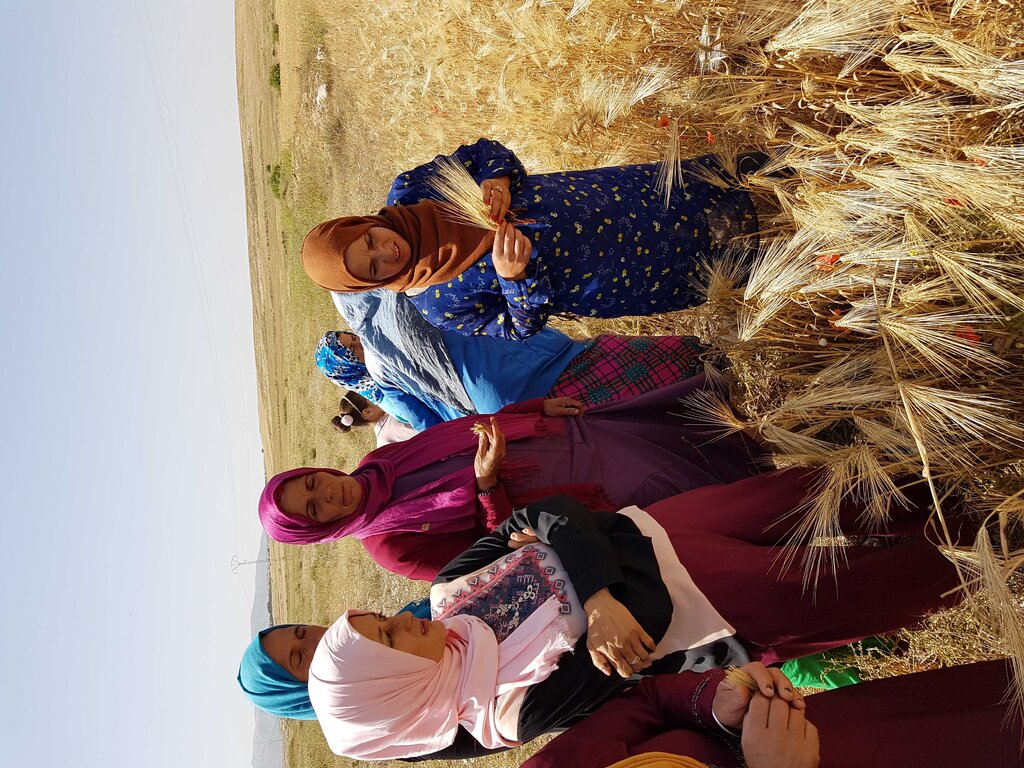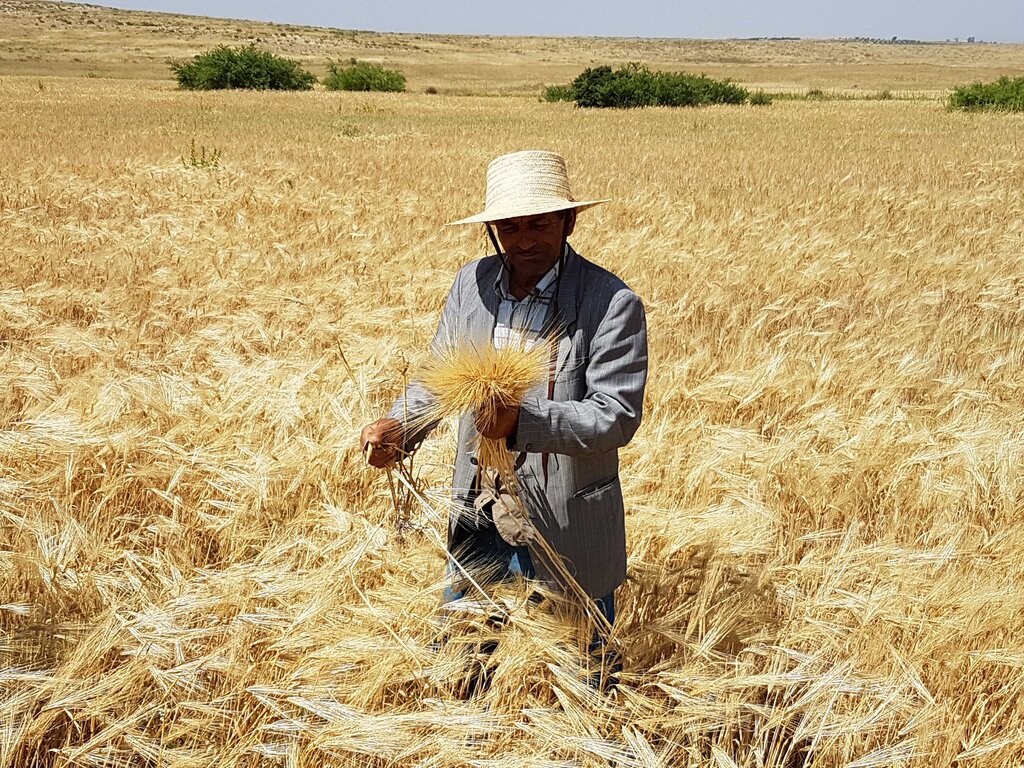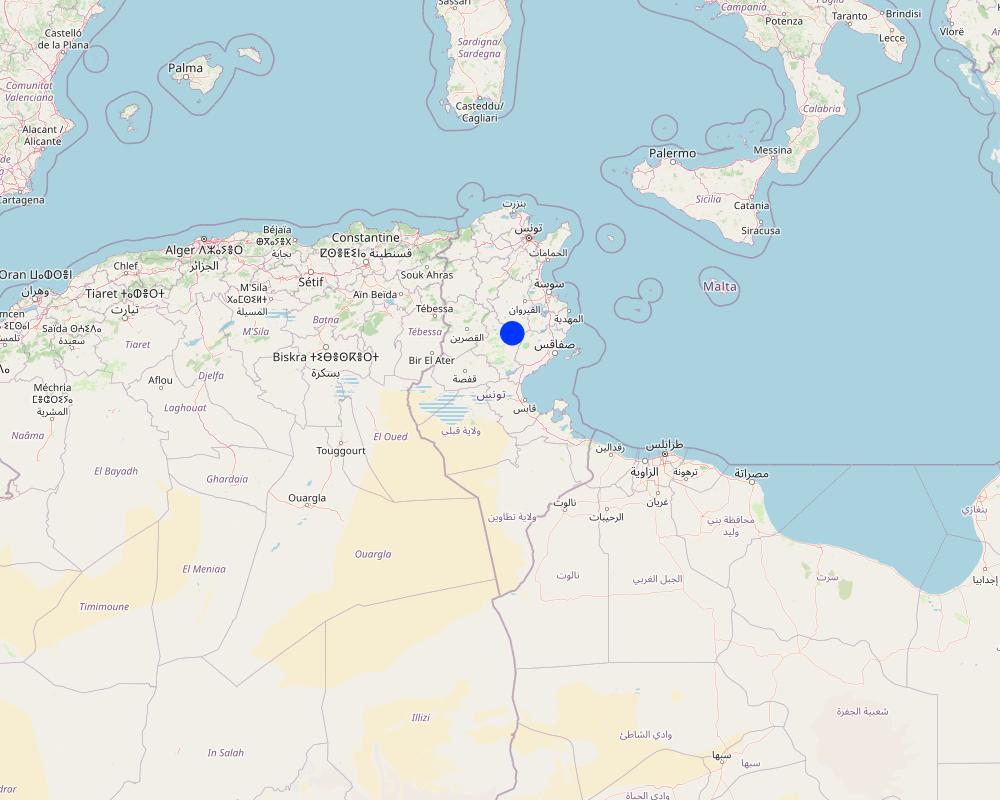Drought tolerant barley variety: 'Kounouz' [Tunisia]
- Creation:
- Update:
- Compiler: Joren Verbist
- Editor: –
- Reviewers: William Critchley, Rima Mekdaschi Studer
technologies_6739 - Tunisia
View sections
Expand all Collapse all1. General information
1.2 Contact details of resource persons and institutions involved in the assessment and documentation of the Technology
Key resource person(s)
Agricultural Innovation Specialis:
Rudiger Udo
International Center of Agriculture Research in the Dry Areas (ICARDA)
Tunisia
Ben Ghanem Hajer
INRAT
Tunisia
Zaiem Anis
OEP
Tunisia
Agricultural Economist:
Frija Aymen
International Center of Agriculture Research in the Dry Areas (ICARDA)
Tunisia
Agricultural and Resource Economist:
Dhehibi Boubaker
International Center of Agriculture Research in the Dry Areas (ICARDA)
Tunisia
Economics and Participatory Methods Expert:
Idoudi Zied
International Center of Agriculture Research in the Dry Areas (ICARDA)
Tunisia
Name of project which facilitated the documentation/ evaluation of the Technology (if relevant)
ICARDA Institutional Knowledge Management InitiativeName of the institution(s) which facilitated the documentation/ evaluation of the Technology (if relevant)
International Center for Agricultural Research in the Dry Areas (ICARDA) - Lebanon1.3 Conditions regarding the use of data documented through WOCAT
The compiler and key resource person(s) accept the conditions regarding the use of data documented through WOCAT:
Yes
1.4 Declaration on sustainability of the described Technology
Is the Technology described here problematic with regard to land degradation, so that it cannot be declared a sustainable land management technology?
No
2. Description of the SLM Technology
2.1 Short description of the Technology
Definition of the Technology:
The introduction of 'Kounouz,' a drought-tolerant barley variety, has significantly enhanced farm income and reduced production risks for small-scale farmers in Tunisia.
2.2 Detailed description of the Technology
Description:
Tunisia has a semi-arid climate with annual precipitation ranging between 200 and 450 millimetres. Many people are dependent on the agricultural sector. Typically, barley is cultivated and used for fodder or sale. Barley production is increasingly in danger of failure because of droughts worsened by climate change. Therefore, a new and drought tolerant barley variety was sought. NARS developed such seed by using germplasm that was made available by the International Center of Agricultural Research in Dry Areas (ICARDA).
As adoption of technologies is often the most difficult part of the innovation process, special care was put into this. It was found that combining different extension methods ranging from technical training to information through SMS led to the highest adoption. And solely focusing on the technical training was the most cost-effective approach. The targeted beneficiaries were small-scale farmers in central Tunisia. Their farm enterprises consist predominantly of small ruminant and cereal production. On average their farm size is 5 hectares and their flocks comprise 20 to 40 sheep and/or goats.
The benefits of the new, drought tolerant variety 'Kounouz' encompass enhanced farm income through reduced production risks and increased yields because Kounouz is better adapted to the semi-arid conditions. It makes more efficient use of water, therefore, Kounouz can produce grain with 300 millimetres of rainfall, whereas the alternative varieties (e.g., Rihane) need at least 350. Under favourable conditions (around 400 millimetres) Kounouz has higher yields than currently available varieties. Kounouz reaches 3 tonnes per hectare of grain, and 4.5 tonnes of straw.
The adoption of this variety has already made significant strides. By 2019, approximately 617 tonnes of certified seeds were available. This accomplishment was the result of successful collaboration between a large-scale cooperative, COSEM, and a private seed company, TUNIFERT. Presently, two more cooperatives, namely SOSEM and CCSPS, have also become actively involved.
It is worth noting that a mere 5% of the Kounouz seeds are estimated to be sourced from certified suppliers, with the majority being multiplied on individual farms. Consequently, it is estimated that the cultivation of Kounouz now spans over 20,000 hectares.
To further facilitate widespread adoption, the establishment of demonstration plots within target regions is imperative. This approach allows farmers, seed companies, and cooperatives to witness production first-hand and become persuaded of its benefits. However, the provision of adequate technical support and comprehensive coaching to farmers is indispensable.
The recommended cultivation practices for Kounouz are typically outlined as follows:
Field preparation, involving ploughing, is initiated at the onset of the rainy season, which generally occurs between September and October. Sowing activities take place in the months of November to December. In order to effectively manage weed growth, herbicide applications are undertaken from December to January. The quantity of herbicide utilized is contingent upon various factors, including climatic conditions, precipitation levels, and the preceding crop type. Notably, cultivating cereal crops after another cereal crop tends to result in a higher weed population compared to the cultivation of legume-cereal rotations. Depending on the geographical location of the farm, the application of mineral fertilizer is scheduled for the months of January to February in North-Western Tunisia. This timeline ensures that the fertilizer is strategically administered to optimize crop growth and yield.
We would like to thank BMZ/ GIZ who supported this innovation through their contributions to the “Mind the Gap” project as well as Tunisian NARES (INRAT, AVFA, OEP, CRDA) for co-implementing project activities
2.3 Photos of the Technology
2.5 Country/ region/ locations where the Technology has been applied and which are covered by this assessment
Country:
Tunisia
Specify the spread of the Technology:
- evenly spread over an area
If precise area is not known, indicate approximate area covered:
- 0.1-1 km2
Is/are the technology site(s) located in a permanently protected area?
No
Map
×2.6 Date of implementation
Indicate year of implementation:
2021
2.7 Introduction of the Technology
Specify how the Technology was introduced:
- as part of a traditional system (> 50 years)
- during experiments/ research
- through projects/ external interventions
3. Classification of the SLM Technology
3.1 Main purpose(s) of the Technology
- improve production
- reduce risk of disasters
- adapt to climate change/ extremes and its impacts
- create beneficial economic impact
- create beneficial social impact
3.2 Current land use type(s) where the Technology is applied
Land use mixed within the same land unit:
No

Cropland
- Annual cropping
Annual cropping - Specify crops:
- cereals - barley

Grazing land
Extensive grazing:
- Semi-nomadic pastoralism
Animal type:
- goats
- sheep
3.3 Has land use changed due to the implementation of the Technology?
Has land use changed due to the implementation of the Technology?
- No (Continue with question 3.4)
3.4 Water supply
Water supply for the land on which the Technology is applied:
- rainfed
3.5 SLM group to which the Technology belongs
- improved plant varieties/ animal breeds
3.6 SLM measures comprising the Technology

agronomic measures
- A5: Seed management, improved varieties
3.7 Main types of land degradation addressed by the Technology

biological degradation
- Bq: quantity/ biomass decline
3.8 Prevention, reduction, or restoration of land degradation
Specify the goal of the Technology with regard to land degradation:
- adapt to land degradation
4. Technical specifications, implementation activities, inputs, and costs
4.1 Technical drawing of the Technology
Technical specifications (related to technical drawing):
Kounouz is advised to be sown with a rate of 120 kilograms per hectare and a spacing of around 18x2 cm
4.2 General information regarding the calculation of inputs and costs
Specify how costs and inputs were calculated:
- per Technology area
Indicate size and area unit:
1 hectare
other/ national currency (specify):
Tunisian Dinar
If relevant, indicate exchange rate from USD to local currency (e.g. 1 USD = 79.9 Brazilian Real): 1 USD =:
3.0
Indicate average wage cost of hired labour per day:
25
4.5 Maintenance/ recurrent activities
| Activity | Timing/ frequency | |
|---|---|---|
| 1. | Field preparation | September - October |
| 2. | Seeding | November - December |
| 3. | Herbicide application | December- January |
| 4. | Fertilizer application | January - February |
| 5. | Harvesting and straw processing | May - June |
4.6 Costs and inputs needed for maintenance/ recurrent activities (per year)
| Specify input | Unit | Quantity | Costs per Unit | Total costs per input | % of costs borne by land users | |
|---|---|---|---|---|---|---|
| Labour | Field preparation | Person-hour | 6.0 | 25.0 | 150.0 | |
| Labour | Sowing | Person-hour | 1.0 | 25.0 | 25.0 | |
| Labour | Fertilizer application | Person-hour | 0.5 | 25.0 | 12.5 | |
| Labour | Weeding | Person-hour | 0.5 | 25.0 | 12.5 | |
| Equipment | Plow | Machine-hour | 8.5 | 25.0 | 212.5 | |
| Equipment | Seeder | Machine-hour | 0.5 | 12.0 | 6.0 | |
| Equipment | Spreader | Machine-hour | 0.5 | 12.0 | 6.0 | |
| Equipment | Combine | Machine-hour | 1.0 | 80.0 | 80.0 | |
| Equipment | Pressor (for straw processing) | Machine-hour | 1.0 | 100.0 | 100.0 | |
| Equipment | Sprayer | Machine-hour | 2.0 | 12.0 | 24.0 | |
| Plant material | Seed | Kilograms | 100.0 | 0.78 | 78.0 | |
| Fertilizers and biocides | DPA | Kilogram | 100.0 | 0.67 | 67.0 | |
| Fertilizers and biocides | Ammonite | Liter | 100.0 | 0.54 | 54.0 | |
| Fertilizers and biocides | Zoom (Herbicide) | Liter | 100.0 | 0.25 | 25.0 | |
| Fertilizers and biocides | Axial (Herbicide) | Liter | 1.0 | 110.0 | 110.0 | |
| Other | Herbicide application (labour) | Person-hour | 0.5 | 25.0 | 12.5 | |
| Other | Harvesting (labour) | Person-hour | 1.0 | 80.0 | 80.0 | |
| Total costs for maintenance of the Technology | 1055.0 | |||||
| Total costs for maintenance of the Technology in USD | 351.67 | |||||
Comments:
This no different than conventional varieties and practices.
5. Natural and human environment
5.1 Climate
Annual rainfall
- < 250 mm
- 251-500 mm
- 501-750 mm
- 751-1,000 mm
- 1,001-1,500 mm
- 1,501-2,000 mm
- 2,001-3,000 mm
- 3,001-4,000 mm
- > 4,000 mm
Agro-climatic zone
- semi-arid
- arid
5.2 Topography
Slopes on average:
- flat (0-2%)
- gentle (3-5%)
- moderate (6-10%)
- rolling (11-15%)
- hilly (16-30%)
- steep (31-60%)
- very steep (>60%)
Landforms:
- plateau/plains
- ridges
- mountain slopes
- hill slopes
- footslopes
- valley floors
Altitudinal zone:
- 0-100 m a.s.l.
- 101-500 m a.s.l.
- 501-1,000 m a.s.l.
- 1,001-1,500 m a.s.l.
- 1,501-2,000 m a.s.l.
- 2,001-2,500 m a.s.l.
- 2,501-3,000 m a.s.l.
- 3,001-4,000 m a.s.l.
- > 4,000 m a.s.l.
Indicate if the Technology is specifically applied in:
- not relevant
5.3 Soils
Soil depth on average:
- very shallow (0-20 cm)
- shallow (21-50 cm)
- moderately deep (51-80 cm)
- deep (81-120 cm)
- very deep (> 120 cm)
Soil texture (topsoil):
- medium (loamy, silty)
Soil texture (> 20 cm below surface):
- coarse/ light (sandy)
- medium (loamy, silty)
Topsoil organic matter:
- low (<1%)
5.4 Water availability and quality
Ground water table:
< 5 m
Availability of surface water:
poor/ none
Water quality (untreated):
poor drinking water (treatment required)
Water quality refers to:
ground water
Is water salinity a problem?
Yes
Is flooding of the area occurring?
No
5.5 Biodiversity
Species diversity:
- low
Habitat diversity:
- low
5.6 Characteristics of land users applying the Technology
Sedentary or nomadic:
- Sedentary
Market orientation of production system:
- mixed (subsistence/ commercial)
Off-farm income:
- 10-50% of all income
Relative level of wealth:
- poor
- average
Individuals or groups:
- individual/ household
- groups/ community
Level of mechanization:
- manual work
- mechanized/ motorized
Gender:
- women
- men
Age of land users:
- middle-aged
- elderly
5.7 Average area of land used by land users applying the Technology
- < 0.5 ha
- 0.5-1 ha
- 1-2 ha
- 2-5 ha
- 5-15 ha
- 15-50 ha
- 50-100 ha
- 100-500 ha
- 500-1,000 ha
- 1,000-10,000 ha
- > 10,000 ha
5.8 Land ownership, land use rights, and water use rights
Land ownership:
- individual, not titled
- individual, titled
Land use rights:
- individual
Water use rights:
- communal (organized)
- individual
Specify:
Land use rights in Tunisia have a long history with religious (e.g. melk) influences and French influences. This resulted in that currently most lands are private owned or state owned.
5.9 Access to services and infrastructure
health:
- poor
- moderate
- good
education:
- poor
- moderate
- good
technical assistance:
- poor
- moderate
- good
employment (e.g. off-farm):
- poor
- moderate
- good
markets:
- poor
- moderate
- good
energy:
- poor
- moderate
- good
roads and transport:
- poor
- moderate
- good
drinking water and sanitation:
- poor
- moderate
- good
financial services:
- poor
- moderate
- good
6. Impacts and concluding statements
6.1 On-site impacts the Technology has shown
Socio-economic impacts
Production
crop production
risk of production failure
Income and costs
farm income
Specify assessment of on-site impacts (measurements):
Expert judgement and (field) data
6.2 Off-site impacts the Technology has shown
Specify assessment of off-site impacts (measurements):
Not significant
6.3 Exposure and sensitivity of the Technology to gradual climate change and climate-related extremes/ disasters (as perceived by land users)
Gradual climate change
Gradual climate change
| Season | increase or decrease | How does the Technology cope with it? | |
|---|---|---|---|
| seasonal rainfall | wet/ rainy season | decrease | very well |
Climate-related extremes (disasters)
Climatological disasters
| How does the Technology cope with it? | |
|---|---|
| drought | very well |
6.4 Cost-benefit analysis
How do the benefits compare with the establishment costs (from land users’ perspective)?
Short-term returns:
positive
Long-term returns:
positive
How do the benefits compare with the maintenance/ recurrent costs (from land users' perspective)?
Short-term returns:
positive
Long-term returns:
positive
6.5 Adoption of the Technology
- 11-50%
Of all those who have adopted the Technology, how many did so spontaneously, i.e. without receiving any material incentives/ payments?
- 11-50%
6.6 Adaptation
Has the Technology been modified recently to adapt to changing conditions?
No
6.7 Strengths/ advantages/ opportunities of the Technology
| Strengths/ advantages/ opportunities in the land user’s view |
|---|
| Increased farm income |
| Improved yields |
| Drought tolerance |
| Strengths/ advantages/ opportunities in the compiler’s or other key resource person’s view |
|---|
| No major changes in land management |
| Increased food security |
6.8 Weaknesses/ disadvantages/ risks of the Technology and ways of overcoming them
| Weaknesses/ disadvantages/ risks in the compiler’s or other key resource person’s view | How can they be overcome? |
|---|---|
| The adoption of Kounouz by more farmers | Installing more pilot/demonstration field so farmers can experience the benefits firsthand, together with adequate training and coaching. |
7. References and links
7.1 Methods/ sources of information
- field visits, field surveys
- interviews with SLM specialists/ experts
- compilation from reports and other existing documentation
When were the data compiled (in the field)?
2021
7.3 Links to relevant online information
Title/ description:
Boubaker Dhehibi, Mohamed Zied Dhraief, Udo Rudiger, Aymen Frija, Jutta Werner, Liza Straussberger, Barbara Rischkowsky. (13/4/2022). Impact of improved agricultural extension approaches on technology adoption: Evidence from a randomised controlled trial in rural Tunisia. Experimental Agriculture, 58, pp. 1-16.
URL:
https://hdl.handle.net/20.500.11766/67344
Title/ description:
Udo Rudiger. (22/4/2020). Mind the Gap: Improving Dissemination Strategies to Increase Technology Adoption by Smallholders_Final Technical Report.
URL:
https://hdl.handle.net/20.500.11766/11120
Links and modules
Expand all Collapse allLinks
No links
Modules
No modules






